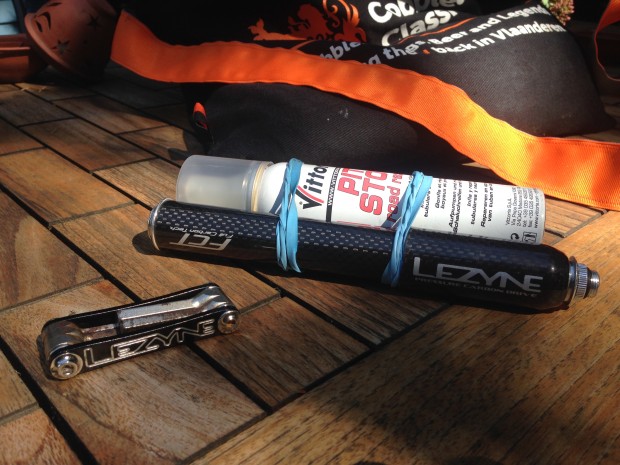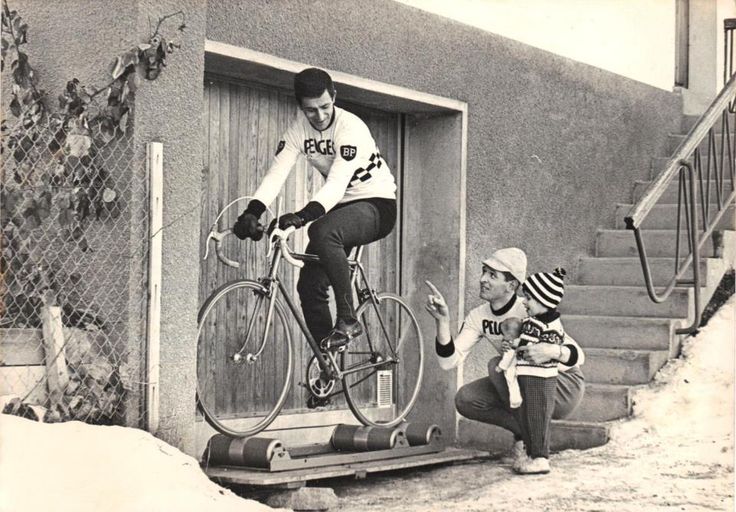Tubular Survival Kit

There was never any question in my mind that tubulars are more romantic than clinchers, and as a Velominatus I was always convinced that the additional time and care that goes into gluing on a set of tires would make you feel just that much more connected to your bike and the history of the sport itself. I was skeptical, however, that tubs would ride noticeably better – and even if they did – whether they would prove to be too much of a hassle to make riding them worthwhile.
Two and a half years after building my first set of tubular wheels and gluing on a set of handmade tires, I have eliminated clinchers from all my bikes. The ride is better, the gluing is a quick and easy process (once you learn a few tricks), and a tubular can be changed more quickly than a clincher. Plus the glue gives you a little buzz; what’s not to like?
The switch from clinchers to tubulars did require a change to my tool kit, however. This fact wasn’t immediately apparent to me and I went on several rides happily armed with tire levers and a spare inner tube. Gearing up for riding tubulars is a more subtle process than it is with clinchers, a fact which gives me no small amount of pleasure. First comes the approach to folding and carrying the spare tire, should you choose to carry one. Also, with the removal of tire levers, spare tube(s), and patch kits comes the introduction of repair sealant; in the event of a flat, the first tactic is to inject the tire with some goop and see if it seals itself, eliminating the need to replace the tire in the first place. This works splendidly in many cases, and appears to be a long-term solution as well; I have one particularly beloved tire which has been holding fast with sealant since a puncture over a year ago.
After a few iterations, my tubular-friendly survival kit has evolved into a beautifully compact system which takes up less bulk in my jersey than does the clincher version. It consists of a Lezyne Carbon Drive Lite rubber-banded to a tube of Vittoria Pit Stop and a Lezyne V5 mini tool. Nothing to it. On longer rides or rides with others, I will strap my tiny tub to my saddle as extra protection in the event the Pit Stop doesn’t work.
Tubulars ride better, corner better, are easy to mount, quick to change, give you a small buzz, and require a smaller survival kit than do clinchers. You heard it here first: friends don’t let friends ride clinchers.*
*Thanks to @Nate for coining this phrase.


@MangoDave
The Nemesis is the Alpha and the Omega. I can ride singletrack on them: they do just fine as long as I’m not riding in a rock garden. I built a set of Cronos up, but even with 36 spokes they’re just barely stiff enough to put up with all 79kg of me atop them. The brake track on the Crono is meh, too.
I had a bad experience with the Reflex rim that involved a trashed rim and some road rash, but that’s a function of my size. They’re very much like the Crono.
I wanted to upgrade the wheels on my Rodriguez this year and looked into tubeless, but couldn’t swing the cost, plus I wasn’t thrilled by the tire options. I came across a used pair of Nucleons and got a wild hair. However I ruined any frugality by springing for some FMB Paris Roubaix 27s to wrap around them. Sweet sweet ride – wider tires and tubular? My butt and wrists have been thanking me. I run these at ~80 psi and I don’t feel I’m giving anything up performance wise to the narrower clinchers I used to ride. Plus I feel safer on fast descents knowing my tire is glued to the rim. I planned on putting my clinchers back on for winter, but I don’t know if I’ll be able to bring myself to do it.
The biggest downside of tubulars is changing / fixing flats, but I realized that I rarely flat on the typical suburban routes I use for training and group rides and in events either. I have an old beater I use for my short commute and errands on the mean city streets. So why forgo all the advantages of tubulars for fear of the flats I never get (yep just cursed myself).
Ok so subject is tubular repair kit. Here’s what I do: I carry a spare tire – I don’t want to get stranded and I don’t want to hold up my riding partners. I don’t carry a spare FMB PR 27, what are you crazy those things cost a fortune! A nice mechanic who inspected my glue job just gave me an old used vittoria 21. Perfect, being used it’s pre-stretched and being 21mm it’s thin and light for packing. Also I was told air pressure is a lot of what holds a tubular on and a 21 can be blasted up to 120psi. I carry a tiny pump to get things started but I also carry CO2. I feel confident that if I need it, this tire will let me finish the ride / get me home. I carry one tire iron to assist in removing the flat. On the advice of an online article I also carry a small 2oz bottle of Stans with one of those tiny valve removal tools taped to it so I could attempt to seal up a small puncture.
However I’m wondering if I should just skip the sealant. I hear it works, but it eventually hardens and you can’t get it out of a tubular. If I got a small puncture on one of my spendy FMBs I might rather put on the spare and send the FMB to that guy in Florida to repair for $20. But, what if I happen to get two flats (though I rarely get even one) or maybe when the FMBs are more than half worn out, I’ll try the sealant figuring in 4-6 mos the tire will be done anyways.